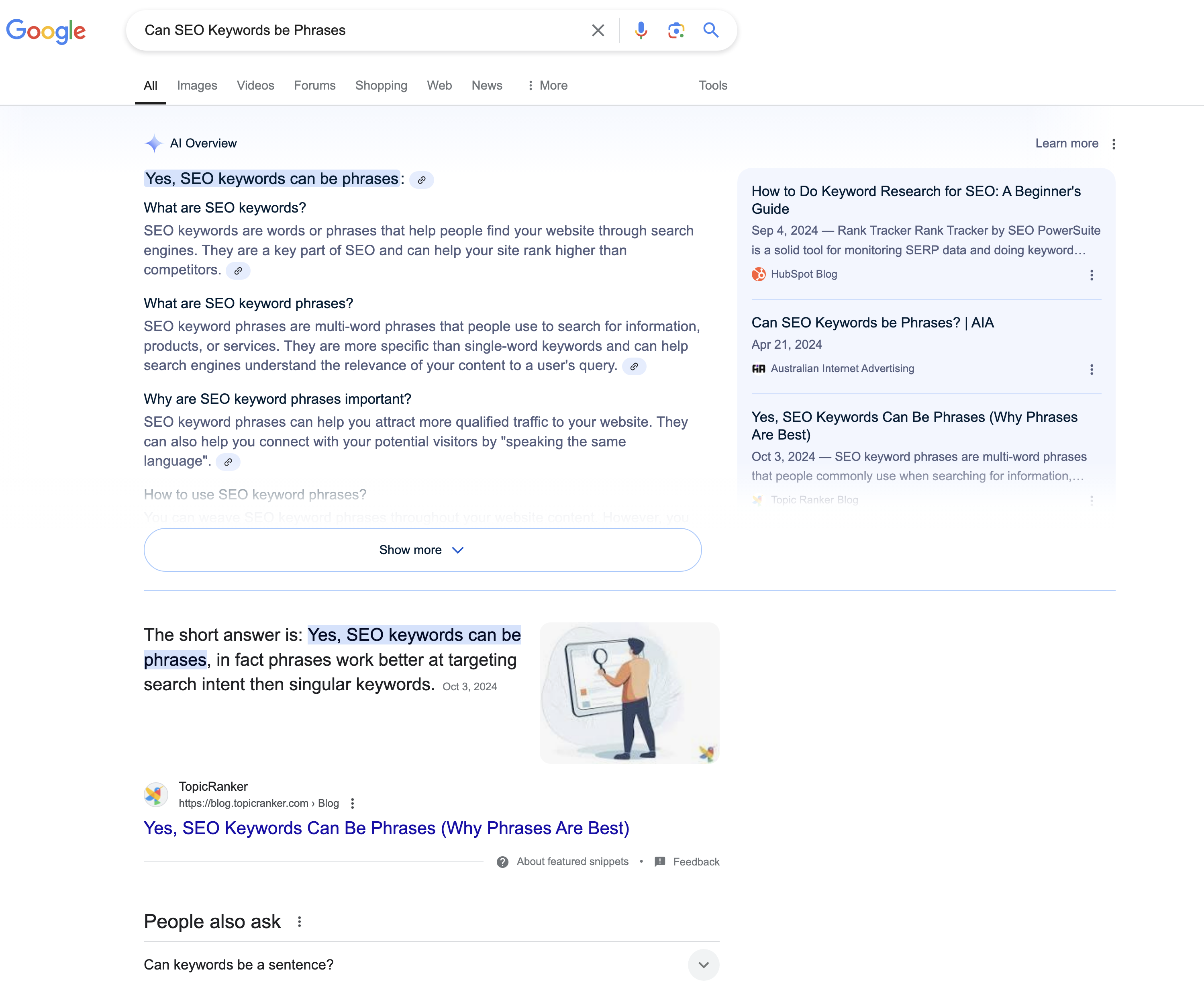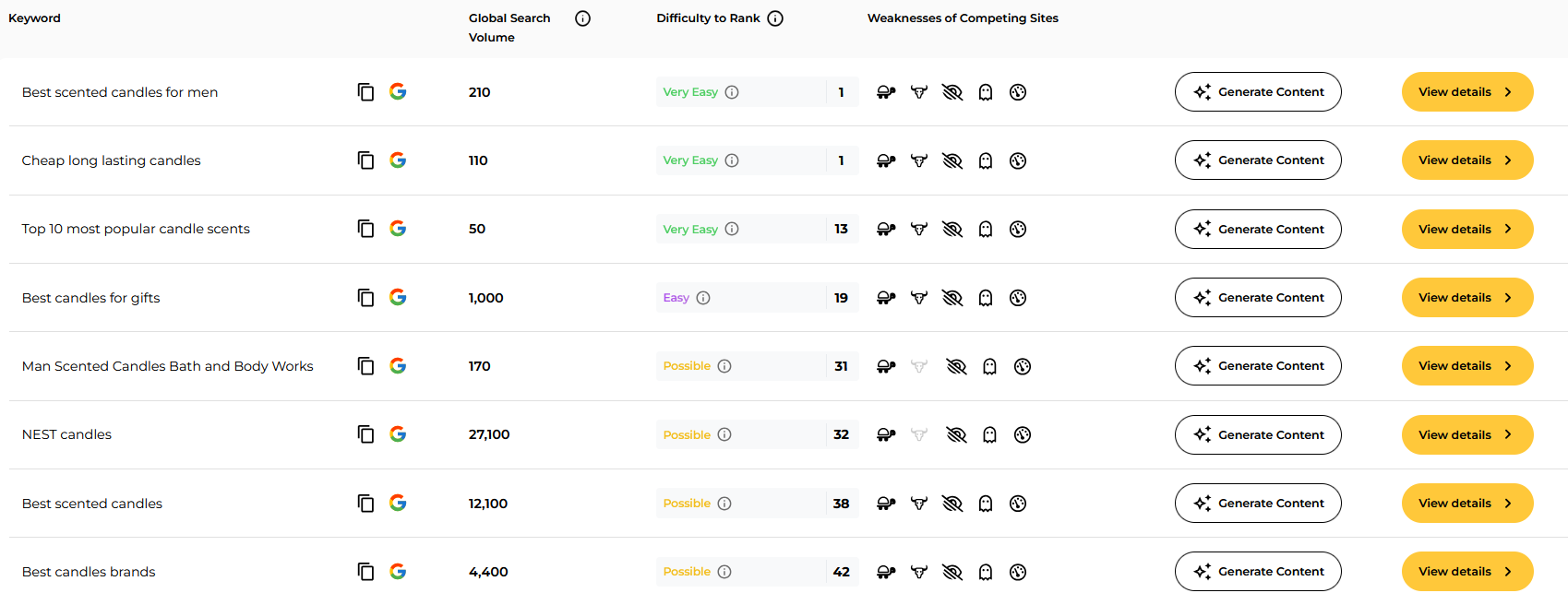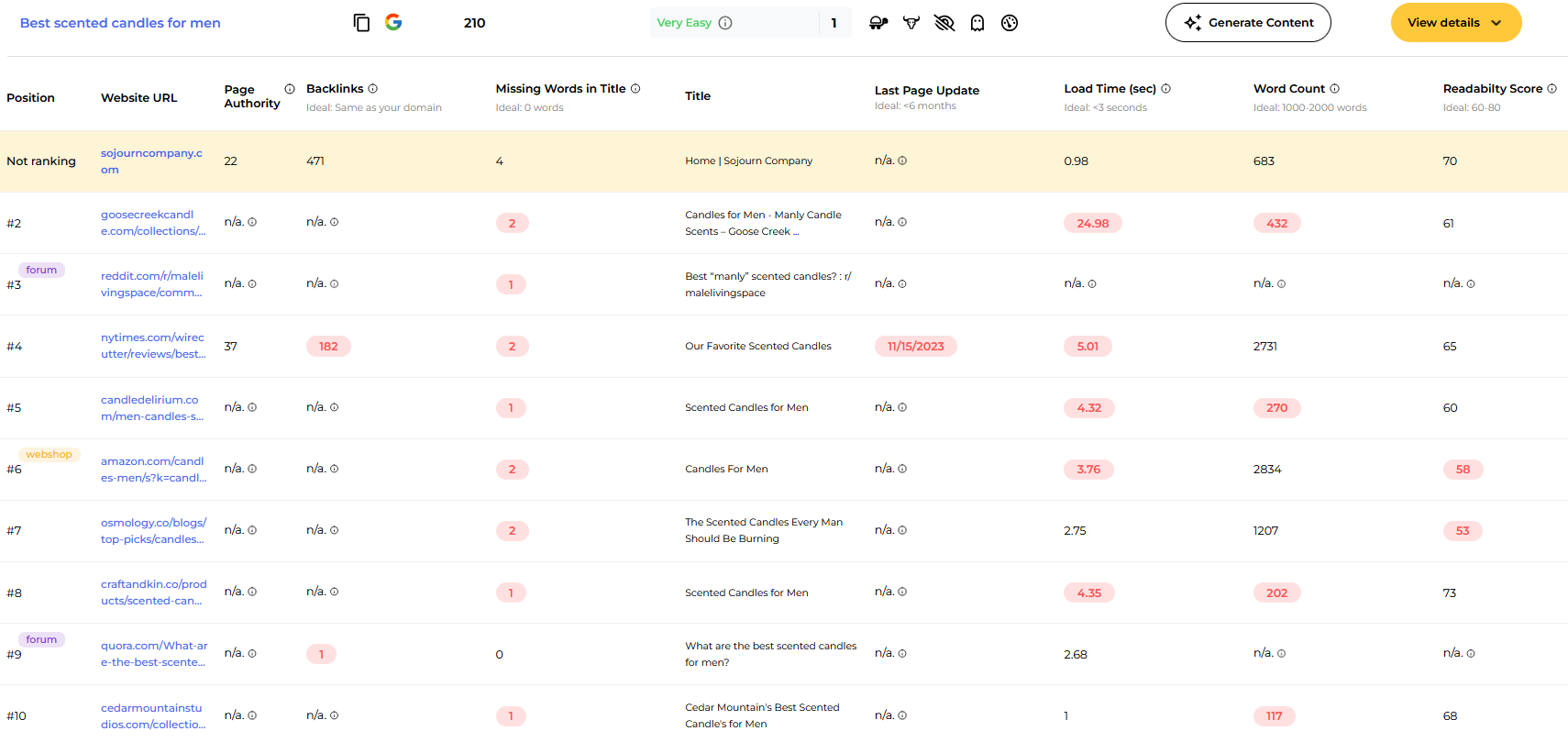In 2025, SEO isn’t just about Google—it’s about optimizing for AI-driven search engines like SearchGPT, which was recently unveiled. These large language models (LLMs) don’t just rank pages; they generate answers, pulling from the best sources they understand. If your content isn’t structured for LLMs, you’re invisible.
So, how do you choose the right keywords for SEO to stay visible on Google, ChatGPT, and SearchGPT? In this guide, you’ll get a 5-step formula to identify keywords that drive traffic, boost rankings, and ensure AI-powered platforms recognize your content.
Let’s dive in.
What are SEO Keywords?
SEO keywords are the words and phrases people type into search engines like Google to find information. They help search engines understand what your content is about and determine where it should rank.
Here is another way to describe SEO keywords:
SEO keywords are terms added to online content in order to improve search engine rankings for those terms.
Before writing a new piece of content you need to engage in keyword research process to find and choose keywords based on search volume, weakness or problems on the SERP (i.e. competition) and of course search intent (is the person searching for the term looking to find information or to transact/buy something).
Types of SEO Keywords:
In most cases seo keywords can be classified or categorized by:
- search intent – is the user Googling the term wants to find information (informational) or ready buy something (commercial) or researching a product (commercial) or researching a person or address or company (navigational)
- keyword phrase length – short-tail keywords ( one or two words in phrase), mid-tail keywords (two to three words), long-tail keywords (three or more words).
These two above are the most popular ways to categorize seo keywords. There are a number of other keyword types of keywords and ways to categorize:
- Clustered keywords – grouping of related keywords in clusters/groups which share a common theme or user search intent.
- Branded Keywords: these include the brand or a brand name or a variation of it.
- Geo-targeted Keywords: these include a specific location information for local SEO.
Using the right keywords strategically in your content improves visibility and rankings on search engines and AI-driven platforms like ChatGPT and SearchGPT in 2025.
Can I Rank on Google & SearchGPT With Same Keyword?
Right now, Google, SearchGPT, and ChatGPT process and rank content differently, so optimizing for one doesn’t guarantee visibility on all. Here’s why:
1. Google SEO (Traditional Search)
Google ranks pages based on backlinks, user behavior, and relevance.
Keywords still matter, but Google also focuses on topic authority and intent.
Read a more detailed account of how Google ranks content below.
2. SearchGPT & ChatGPT (AI-Driven Search)
These don’t just rank pages—they generate answers from trusted sources.
They prioritize context, factual accuracy, and entity-based SEO over exact-match keywords.
Information gain (new insights, unique data) increases visibility.
Should You Choose Keywords for both LLMs and Google?
Yes—but with a strategic approach.
For Google: Use search volume + competition data to find ranking opportunities.
For AI-driven search (SearchGPT, ChatGPT): Focus on semantic search, entity-based optimization, and structured content that teaches LLMs about your expertise.
Can Ranking on One Boost Visibility on Others?
Ranking on Google helps AI models find and learn from your content, increasing your chances of appearing in LLM-generated answers.
But LLMs prioritize high-authority, well-structured data, so just ranking on Google won’t guarantee visibility on SearchGPT or ChatGPT.
Bottom Line:
- Optimize for Google + AI search together by using:
- Well-structured, in-depth content (trusted by LLMs)
- Entities & context-based SEO (not just keywords)
- Topic clusters & FAQs (to be featured in AI-generated answers)
Where Does SearchGPT Get Its Data?
SearchGPT is still somewhat new so we are still learning where it gets it’s data from, but from the latest news and research as of March , 2025 SearchGPT likely uses a combination of the following data sources, including:
- Bing API: Microsoft’s Bing search engine powers many AI-driven systems, including SearchGPT. The Bing API provides real-time search data, indexing, and ranking signals.
- Google: While SearchGPT doesn’t directly pull from Google’s search results, it can be trained on content indexed from Google, so the information it provides is influenced by Google’s ranking signals and content.
- Other AI Training Sources: SearchGPT’s responses are influenced by OpenAI’s LLM training data, which likely includes information scraped from a wide variety of sources, such as online articles, forums, social media, and other publicly available datasets, ensuring it can answer in a contextually accurate way.
Choosing Keywords for Ranking on SearchGPT vs. ChatGPT
SearchGPT and ChatGPT are fundamentally two different platforms and it’s important to understand the key differences in how each one operates and ranks content before you start choosing keywords. Here is a quick overview:
| Feature | SearchGPT | ChatGPT |
|---|---|---|
| SEO Keywords | Focuses on semantic search and intent matching; ranks based on relevance and context. | No focus on SEO keywords; generates responses based on conversational context. |
| Ranking of Content | Ranks content by semantic relevance and authority signals, using web-based data. | No ranking of content; generates contextual answers based on the prompt. |
| Links/References to Results | Provides direct links or references to sources used in generating the answer (if applicable). | Does not provide links or references to external content. |
| Real-Time Content Ranking | Can rank content based on real-time web data and search intent. | Cannot rank content in real time; relies on pre-trained data. |
| Search Intent Matching | Matches search intent based on web data, focusing on actionable keywords. | Responds to conversational prompts without considering search intent. |
Focusing on optimizing for SearchGPT could be a strategic move for any marketer doing SEO in 2025, especially if you’re aiming to get visibility in AI-driven search environments.
Why Optimize for SearchGPT vs. ChatGPT
Direct Links and Traffic:
SearchGPT tends to provide direct links and references to external content (websites), which can drive traffic to your site if your content ranks well. This makes it more like a search engine where your content can be linked and clicked on by users seeking specific answers.
Actionable Visibility:
Unlike traditional SEO where you aim to rank on Google’s search results page, SearchGPT focuses on providing direct answers to user queries. If your content aligns well with the search intent and the keywords used in SearchGPT’s algorithm, it could get more exposure. This can lead to more visibility, increased click-through rates, and ultimately more traffic for lead generation.
Semantic SEO:
SearchGPT is likely to prioritize semantic relevance and contextual understanding of keywords. This means your content needs to focus on the intent behind the keywords, making it contextually valuable for the searchers. Optimizing for semantic search is becoming more crucial, and SearchGPT is aligned with these trends.
Future-Proofing:
As platforms like SearchGPT continue to evolve, focusing on these new AI-driven tools can give you a competitive edge. Ranking in such platforms may not only bring in traffic but also help you stay ahead in the changing SEO landscape.
How To Choose Keywords to Rank on Google
Here’s an example of how Google ranks content using SEO keywords and other factors. Let’s pick the following example topic:
Example Topic: “How to Choose SEO Keywords for Your Website”
Here is what happens:
Search Query: A user types “how to choose SEO keywords” into Google.
Google’s executes it’s Ranking Factors:
- Relevance to Search Intent: Google looks for content that closely matches what users are looking for. It will prioritize pages that provide a comprehensive, step-by-step guide on choosing SEO keywords (rather than just listing random keywords).
- Keyword Placement: Google checks how well the search term “how to choose SEO keywords” is used on the page, especially in the title tag, meta description, headings, and throughout the content.
- Content Quality: High-quality content that answers the question in-depth. For example, a post that explains how to do keyword research, tools to use, and how to implement the keywords into the site’s SEO strategy.
- Backlinks: Google evaluates how many other websites link to your page as a sign of authority. More high-quality backlinks improve the page’s rank.
- User Engagement: Google analyzes user signals like click-through rate (CTR), bounce rate, and time spent on page. Pages with high engagement tend to rank higher.
- Mobile Optimization: Since more people use Google on mobile, Google prioritizes pages that are mobile-friendly.
Outcome:
If your page uses the keyword “how to choose SEO keywords” in the right places, provides valuable, original information, and has quality backlinks, it’s more likely to rank higher.
Google will serve the most relevant, high-quality pages based on the user’s query, considering both on-page factors (keywords, structure) and off-page factors (backlinks, authority).
This ranking process happens in milliseconds, using a mix of algorithms that evaluate over 200 ranking factors.
5 Steps To Choose Right Keywords To Rank On Google
The basic steps to choose the right keywords are rather simple, here is the basic process I go through:
1. Understand Your Audience’s Search Intent
If you’re writing about “best laptops for gaming,” users might be looking for product recommendations or buying guides. Your keyword could be “best gaming laptops 2025”. The intent is transactional (to buy) or informational (to learn about options).
2. Conduct Keyword Research
For example if you use Google Keyword Planner to search for the term “SEO tools” you might discover related keywords like “best SEO tools for beginners” or “free SEO tools”. These variations give you more targeted options to rank for.
Another example: You can use TopicRanker to identify weaknesses in search results to help you find low-hanging fruit—keywords that are easier to rank for. It analyzes the SERP (Search Engine Results Pages) and highlights content ranking in top 10 results with problems, gaps or areas where competition is low or ineffective, allowing you to target keywords with high potential but less SEO investment. It looks for the following weaknesses:
- Low-Quality Content: If the top-ranking pages are poorly written or lack depth, you can create better, more valuable content that meets user intent, making it easier to rank.
- Thin Content: When search results show short, under-informative content, you can optimize with more comprehensive articles to fill the gap, improving your chances of ranking higher.
- Low Authority Pages: If high-ranking pages have low domain authority or are not credible sources, TopicRanker can help you spot these opportunities, allowing your more authoritative content to rank better.
- Keyword Overlap: If multiple pages are targeting the same keywords but fail to differentiate content or provide distinct answers, TopicRanker helps you find opportunities to stand out by focusing on specific subtopics.
- Lack of Long-Tail Keywords: Many search results fail to target specific, longer phrases that users are actually searching for. TopicRanker uncovers these long-tail keyword gaps, helping you rank for more specific, low-competition keywords.
3. Analyze Search Volume and Competition
After researching “SEO tools,” you find that the keyword “best SEO tools” has a high search volume (20,000 searches/month) but is highly competitive. On the other hand, “best free SEO tools for bloggers” has moderate search volume (1,500 searches/month) but lower competition. Choosing the second one could help you rank faster.
4. Focus on Relevance and Context
If you’re writing a blog about “how to start a blog”, the keyword “starting a blog for beginners” fits because it matches the content you’re offering and targets users specifically interested in beginner-level advice.
5. Optimize Your Content for Keywords
Example: If your target keyword is “SEO tools for small businesses”, include it in strategic places like:
- Title: “Top 10 SEO Tools for Small Businesses in 2025”
- Meta Description: “Discover the best SEO tools for small businesses to grow your online presence.”
- Headings: “Why SEO Tools Are Essential for Small Businesses”
- Body Content: Naturally include phrases like “SEO tools for small business owners” or “affordable SEO tools.”
By applying these steps with specific examples, you can optimize your content to effectively rank on Google.
5 Steps To Choose Right Keywords For SearchGPT
SearchGPT is still a very new platform which has only been around for less than a year, we are still learning about it. But here are the 5 key steps to choose the right keywords, helping you rank higher and improve visibility in SearchGPT’s results. Let’s dive into the process.
1. Understand User Intent and Search Queries
How: SearchGPT analyzes how users phrase their queries and what they expect in return. Identify whether the intent is informational, transactional, or navigational. This step is crucial to make sure you’re targeting the right type of keywords that align with user expectations.
Example: If users search for “best SEO tools”, SearchGPT interprets this as transactional intent, meaning users want recommendations or product comparisons to make a purchase. In contrast, if they search for “SEO tools tutorial”, it’s more informational intent, where they want to learn how to use SEO tools.
2. Use Semantic Keyword Research
How: SearchGPT values semantic relevance rather than just exact-match keywords. It looks at context and meaning behind words to serve better answers. Use tools like TopicRanker to find related terms and semantic clusters.
Example: If your keyword is “SEO tools,” SearchGPT might also rank content targeting related phrases like “top SEO software,” “SEO tools for businesses,” or even “best tools for website optimization.” These terms expand the conversation and improve visibility for related topics.
3. Analyze Keyword Performance Across AI Platforms
How: Analyze how well specific keywords are ranking in AI-driven platforms like SearchGPT. Since SearchGPT is powered by AI, it will prioritize terms that it sees as highly relevant in AI-generated content and conversations.
Example: If you’re targeting “best SEO tools”, SearchGPT might prioritize content that answers questions in conversational formats and includes phrases like “best free SEO tools” or “SEO tools for beginners.” This is because SearchGPT learns from queries and conversations that occur naturally in the real world.
4. Consider Long-Tail Keywords for Better Accuracy
How: Focus on long-tail keywords, which are more specific and align better with SearchGPT’s natural language processing. Long-tail keywords often reflect more precise user needs and improve ranking chances on AI-driven platforms.
Example: Instead of just targeting “SEO tools,” use “best free SEO tools for small business owners”. This targets a specific group with a more defined need, and it’s easier to rank for compared to a general keyword, especially since SearchGPT prefers more specific, contextually relevant content.
5. Optimize Content for Natural Language Processing
How: Make sure your content is structured for natural language understanding. SearchGPT focuses on conversational answers, so optimizing content with direct answers, questions, and natural language helps improve ranking.
Example: Instead of writing a general list of tools, create content that answers questions like “What are the best SEO tools for beginners?” or “How can SEO tools help small businesses?” By writing your content to answer these conversational queries, you align better with the way SearchGPT interprets and ranks content.
How To Find Keywords For SEO – Traditional Approach
I used to find keywords rather simply using the following approach before 2024, I wanted to keep this part in this article to share how this process used to work before LLMs such as ChatGPT and SearchGPT have changed the SEO landscape. Here is the process which at it’s core still working even today:
1. Define Your Target Audience and Niche
Identifying your ideal customer persona is the foundation of successful keyword research. You need to understand who your target audience is, their demographics, interests, and online behavior.
What are their needs, challenges, and pain points? How do they describe their problems and search for solutions online? Answering these questions helps you step into your audience’s shoes and select keywords that resonate with them.
Analyze the language and terminology your target audience uses when discussing your niche or industry. Observe how they communicate on forums, social media, and online communities. Incorporate these insights into your keyword research to ensure you’re targeting the right phrases.
Determine your unique value proposition within your niche. What sets you apart from competitors? Why should your target audience choose your website over others?
Your unique selling points guide your keyword selection, helping you focus on terms that highlight your strengths and differentiate you from the competition.
2. Brainstorm Keyword Ideas
Start by listing broad topics relevant to your business, products, or services. These topics serve as the foundation for your keyword research. Consider the main categories, features, and benefits you offer, as well as the problems your target audience is trying to solve.
Use keyword research tools to expand your list and discover related keywords. These tools provide valuable insights into the search terms people use when looking for content similar to yours. Enter your broad topics and let the tools generate a list of potential keywords to target.
Analyze your website’s existing traffic sources to identify keywords already driving visitors to your site. Use Google Search Console or other web analytics tools to see which search terms people use to find your content. This helps you understand what’s working well and uncover new keyword opportunities.
Gather insights from customer feedback, interactions, and support queries. Pay attention to the language your customers use when describing their needs, challenges, or experiences with your products or services. These insights can reveal valuable long-tail keywords and content ideas that directly address your audience’s needs.
3. Analyze Keyword Metrics
Assessing keyword search volume and popularity reveals how many people are searching for a specific term each month. Higher search volume indicates greater potential for attracting organic traffic. However, high-volume keywords also tend to be more competitive.
Evaluating keyword difficulty and competition level helps you gauge the effort required to rank for a particular keyword. Keyword difficulty scores, provided by various SEO tools, estimate how challenging it would be to outrank competitors for a given term. Higher difficulty scores suggest more intense competition.
Considering long-tail keywords, which are longer and more specific phrases, allows for targeted traffic and less competition. While long-tail keywords have lower search volumes, they often attract users with clear intent and higher conversion potential.
Keyword Metrics to Consider
Monthly search volume indicates the average number of searches for a keyword over a 12-month period. This metric helps prioritize keywords based on their popularity and potential traffic. Aim for a balance between high search volume and relevance to your content.
Keyword Difficulty (KD) scores, typically on a scale of 0 to 100, estimate the level of competition for a keyword. Higher KD scores suggest more effort required to rank on the first page of search results.
Focus on keywords with manageable difficulty levels based on your website’s authority and resources.
Cost-Per-Click (CPC) values reflect the average amount advertisers pay for a click on their ad when targeting a specific keyword. Higher CPC values often correlate with greater commercial intent and potential for monetization. Incorporate CPC data to prioritize keywords with higher conversion potential.
Competitor analysis involves examining the websites currently ranking for your target keywords. Assess their domain authority, backlink profiles, content quality, and user engagement. Identify gaps in their content or areas where you can provide unique value to outrank them.
Analyzing competitor keywords helps refine your strategy and uncover untapped opportunities.
4. Prioritize Keywords by Relevance and Intent
Map each keyword to a specific page or piece of content on your website. This ensures that your keyword targeting is focused and organized. Each page should target a primary keyword and a set of related secondary keywords.
Align your keywords with user intent. Understand the purpose behind a user’s search query and categorize your keywords accordingly:
- Informational intent: Users seeking information, answers, or knowledge.
- Navigational intent: Users looking for a specific website or webpage.
- Commercial intent: Users researching products or services before making a purchase decision.
- Transactional intent: Users are ready to make a purchase or complete an action.
Matching your keywords with the appropriate user intent helps you create content that meets the user’s needs and expectations, leading to higher engagement and conversions.
Prioritize your keywords based on their relevance to your business goals. Focus on keywords that align with your products, services, and overall marketing objectives.
Keywords closely related to your core offerings should take precedence over broad or peripheral terms. Relevance ensures that the traffic you attract is more likely to convert into leads or customers.
Consider the balance between keyword search volume, competition, and relevance when prioritizing your keyword list. High-volume, low-competition keywords that are highly relevant to your business are the ideal targets.
However, also include relevant long-tail keywords with lower search volume, as they can drive targeted traffic and have less competition.
Regularly review and update your keyword priorities based on changes in your business, industry trends, and search behavior. Stay agile and adapt your keyword strategy to capitalize on new opportunities and maintain your competitive edge in search results.
5. Conduct SERP Analysis for Target Keywords
Once you’ve prioritized your target keywords, analyze the top-ranking pages for each term. This SERP (Search Engine Results Page) analysis provides valuable insights into the content type, format, and quality that search engines and users prefer for a given keyword.
Visit the top search results for your target keyword and assess the content elements on each page. Are the top-ranking pages blog posts, product pages, or informational guides? What is the average word count of the content? Do the pages include images, videos, or interactive elements?
Analyzing the content format and structure of top-ranking pages helps you understand the expectations of search engines and users. You can then align your content strategy with these preferences to increase your chances of ranking higher.
Evaluate the quality and depth of the content on top-ranking pages. Are they providing comprehensive, well-researched information? Do they cover the topic from multiple angles and address common questions or concerns?
Assessing content quality helps you identify areas where you can differentiate your content and provide greater value to users.
Look for content gaps and opportunities in the top search results. Are there any subtopics or questions that the current top-ranking pages fail to address adequately? Identifying these gaps allows you to create content that fills those voids and provides a more complete resource for users.
SERP analysis tools, like TopicRanker, automate much of this process and provide detailed insights into the top-ranking pages for your target keywords. These tools analyze factors such as keyword usage, content length, backlinks, and more, giving you a comprehensive overview of the competitive landscape.
Leverage SERP analysis tools to uncover additional keyword opportunities, identify content trends, and track your competitors’ strategies. These insights inform your content creation and optimization efforts, helping you craft content that aligns with user intent and outperforms the competition.
6. Optimize Your Content for Chosen Keywords
Once you’ve selected your target keywords, integrate them into your content naturally. Incorporate your primary keyword in the title, headings, and throughout the body of your text. Use secondary keywords to support your main topic and provide context.
Place your primary keyword in key on-page elements such as the title tag, meta description, and H1 heading. This helps search engines understand the main focus of your content and improves its visibility in search results.
Craft comprehensive, high-quality content that aligns with the search intent behind your chosen keywords. If users are searching for informational content, provide in-depth, well-researched articles that answer their questions.
If the intent is transactional, focus on product descriptions, reviews, and clear calls-to-action.
When optimizing your content, avoid keyword stuffing, which is the practice of excessively repeating keywords in an unnatural way. Search engines penalize content that appears spammy or manipulative. Instead, use keywords strategically and prioritize readability and user experience.
Remember, the goal of keyword optimization is to create valuable, relevant content that satisfies user needs and search intent. Focus on providing a great user experience while naturally incorporating your target keywords.
Generating high-quality content that matches search intent and incorporates your chosen keywords will help your website rank higher in search results and attract targeted organic traffic.
7. Monitor Keyword Performance and Adjust Strategy
Monitoring keyword performance is an ongoing process that involves tracking your rankings and organic traffic for targeted keywords. Use tools like Google Analytics and Google Search Console to measure the impact of your SEO efforts and identify areas for improvement.
Pay close attention to your keyword rankings over time. Are your targeted keywords moving up in search results? Are you maintaining or improving your positions for important terms?
Regularly check your rankings to gauge the effectiveness of your optimization efforts and identify any fluctuations or drops that may require attention.
Analyze your organic traffic data to see which keywords are driving the most visitors to your website. Look for trends and patterns in your traffic sources and identify the keywords that generate the highest engagement and conversion rates.
This information helps you prioritize your keyword strategy and focus on the terms that deliver the most value to your business.
Evaluate your click-through rates (CTR) for targeted keywords. CTR measures the percentage of users who click on your website’s listing in search results when it appears for a specific keyword.
Higher CTRs indicate that your title tags, meta descriptions, and content snippets are compelling and relevant to users’ search queries. Optimize these elements to improve your CTRs and attract more qualified traffic.
Assess user engagement metrics such as bounce rate, time on page, and pages per session for visitors landing on your website from targeted keywords. These metrics provide insights into how well your content resonates with users and meets their expectations.
High engagement levels suggest that your content is valuable and relevant, while low engagement may indicate a need for improvement or better alignment with search intent.
Continuously monitor your keyword landscape for new opportunities and gaps. As you track your performance, keep an eye out for emerging keywords or related terms that you may not have initially targeted. Analyze your competitors’ keyword strategies and identify areas where you can differentiate yourself and capture additional search traffic.
Use the insights gained from monitoring your keyword performance to refine and adjust your SEO strategy. Regularly review your keyword targets, content optimization, and overall approach based on the data and feedback you receive.
Adapt to changes in search trends, user behavior, and competitive landscape to stay ahead and maintain your search visibility.
Keyword performance analysis is a continuous process that requires diligence and flexibility. Stay proactive in monitoring your rankings, traffic, and engagement metrics, and be ready to make data-driven decisions to optimize your keyword strategy for long-term success.
Why Choosing the Right SEO Keywords Matters
Selecting the right SEO keywords has a significant impact on your website’s performance and ability to reach your target audience. When you target relevant keywords, you attract users who are actively searching for the products, services, or information you offer.
This leads to higher quality traffic, as these users are more likely to engage with your content and convert into customers or subscribers.
Targeting the right keywords also improves your website’s visibility and search rankings. When your content is optimized for relevant keywords, search engines are more likely to recognize its value and relevance to users’ queries.
As a result, your website can rank higher in search results, making it easier for users to find and access your content.
Choosing the right SEO keywords helps you understand and meet user needs. By researching the keywords your target audience uses, you gain insights into their interests, pain points, and search intent.
This knowledge enables you to create content that directly addresses their needs and provides value, leading to a better user experience and increased engagement.
Your keyword research guides your content strategy and optimization efforts. By identifying the most relevant and valuable keywords for your business, you can prioritize content creation and optimization tasks. This ensures that your efforts are focused on the keywords that have the greatest potential to drive traffic, conversions, and growth.
Ultimately, targeting the right SEO keywords enhances the user experience and engagement on your website. When users find your content through relevant search queries, they are more likely to find it useful, informative, and engaging.
This leads to longer site visits, lower bounce rates, and increased chances of conversion, as users recognize your website as a valuable resource in your industry or niche.
Final Thoughts
Choosing the right keywords for SEO requires a strategic and data-driven approach. Understand your audience, analyze keyword metrics, prioritize relevance and intent, and optimize your content effectively. Improve your search visibility and drive targeted organic traffic to your website. Continuously monitor and adapt your keyword strategy for long-term SEO success.
TopicRanker simplifies the keyword research process, helping you identify easy-to-rank keywords based on weak spots in the SERP. Empower your SEO strategy and content creation with data-driven insights.
Sign up for your account and find those easy to rank keywords today!
Frequently Asked Questions
What are the Best Tools for Keyword Research?
Use tools that provide comprehensive data on search volume, keyword difficulty, and competitor analysis to uncover effective keywords for your SEO strategy.
How Many Keywords Should I Target Per Page?
Focus on one primary keyword and include several secondary keywords that are relevant and support the main topic to enhance your content’s visibility.
How Often Should I Revisit My Keyword Strategy?
Revisit your keyword strategy quarterly to ensure it aligns with current search trends, user behavior, and your business goals.
What is the Difference Between Short-Tail and Long-Tail Keywords?
Short-tail keywords are broader and more competitive, while long-tail keywords are more specific and usually have lower competition, making them easier to rank for.
How Do I Balance Keyword Optimization with User Experience?
Integrate keywords naturally into high-quality content that meets user intent without overstuffing, ensuring readability and relevance.

Dmitry is the founder of TopicRanker – a software tool to find problems & weaknesses on Google search results and discover keywords you can easily rank for with your website. Over the last 10 years, Dmitry has helped 300+ brands rank #1 on Google through PR and SEO. Dmitry used PR & SEO to grow a startup from 0 to 40 million views per month, and got acquired by Google in 2014. He translated his know-how into JustReachOut.io, a SaaS tool to get covered in press and build authority backlinks without PR firms; it’s been used by 5000+ content marketers to date and was acquired in 2020.





